Unsolved Chess Mysteries (16)
By Edward Winter
Did Lasker invent a tank?
In Psychoanalytic Observations on Chess and Chess Masters (New York,
1956) Reuben Fine stated (page 51) that Lasker ‘invented a kind of tank
in World War I’. (In the 1967 Dover reprint, The Psychology of the
Chess Player, the quote is on page 45.) C.N. 3650 asked what more is known
about this. Can readers assist?

Emanuel Lasker
Who stated what?
The following remark appeared on page 111 of Irving Chernev’s The
Bright Side of Chess (various editions, except the New York, 1961 version,
which mysteriously omitted the Epigrams chapter):
‘Once get a knight firmly posted at king 6 and you may go to sleep.
Your game will then play itself.’
This is attributed to Anderssen, whereas on page 174 of CHESS, 8 January
1955 Steinitz was said to have declared:
‘Let me establish an unassailable knight on K6 and I can go to sleep
for the rest of the game.’
Can a reader provide a respectable nineteenth-century source relating to Anderssen,
Steinitz or anybody else?
A similar observation was also mentioned in C.N. 2194. On page 279 of The
Chess Companion (New York, 1968) Chernev attributed the following to Tartakower:
‘The great master places a knight at K5; checkmate follows by itself.’
As was pointed out, Tartakower merely quoted an onlooker at a game won by O.
Bernstein in Paris in 1933. On page 426 of L’Echiquier, 17 February
1934 Tartakower wrote:
‘“Ces grands-maîtres placent leur[s] Cavaliers
à é5 et après les mats découlent d’eux-mêmes!” dit en voyant cette
catastrophe un spectateur grincheux.’
Lansing v Hart
C.N. 4782 noted that a number of databases give the following as a correspondence
game played by Lansing and Hart in 1985:
1 e4 e5 2 f4 exf4 3 Nf3 g5 4 Bc4 d6 5 O-O Bg4 6 h3 h5 7 hxg4 hxg4 8 Ne1 g3
9 Rf3 Nd7 10 d4 Ngf6 11 Nc3 Ng4 12 Bxf4 Nf2
13 Bxg3 Nxd1 14 Bxf7+ Ke7 15 Nd5 mate.
In reality, the game had been published on page 24 of the November 1907 issue
of Lasker’s Chess Magazine:
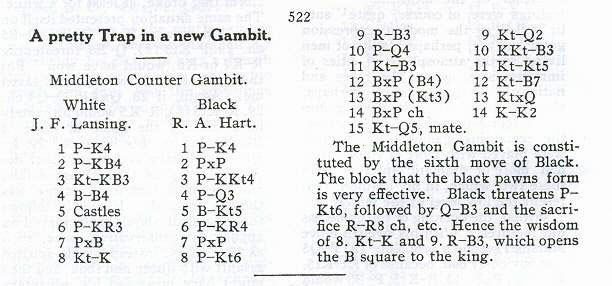
How did the ‘1985’ claim arise?
Hans Frank
From 1939 to 1945 Hans Frank kept a diary, 11,000 typewritten foolscap pages,
comprising 38 volumes, and some of the material has been published over the
years. As mentioned in C.N. 3562, one such publication (from which the above
statistics are taken) is Hans Frank’s Diary by S. Piotrowski (Warsaw,
1961). It is a 320-page book, but the diary excerpts do not begin until page
207. No references to chess have been noted, but did Frank’s complete
Tagebücher did ever mention Alekhine, Bogoljubow (whom he met several
times) or, more generally, chess under the Nazi regime? Has the matter ever
been investigated by, in particular, Polish or German chess researchers?
The Foreword to the above-mentioned book (page 6) states:
‘Hans Frank’s Diary was handed over to the Polish authorities
after the close of the Nuremberg trial and is now in the archives of the Ministry
of Justice in Warsaw.’
Mieses v Bogoljubow
In his report to the 1929 session of the FIDE General Assembly in Venice, Alexander
Rueb stated that he would explain orally a complaint by Mieses against Bogoljubow.
The affair was decided by FIDE in favour of Mieses. This information appeared
on pages 4 and 5 of the minutes of FIDE’s 1929 General Assembly, but the
nature of Mieses’ grievance was not indicated. C.N. 3941 asked for information
about the affair.
Movement
C.N. 3781 quoted from page 32 of CHESS, November 1948:
‘According to an announcement by Grob, Bogoljubow has invented a new
game of “movement”, using chessmen and the chessboard. The whole
game lasts at most 35 moves.’
Wanted: more details.
Meister Mieses
C.N. 4729 asked about the origins of the famous ‘Mister Meises/Meister
Mieses’ story, mentioning that on page 182 of CHESS, 20 March 1960
B.H. Wood wrote, ‘This anecdote first appeared in print in CHESS
many years ago’.
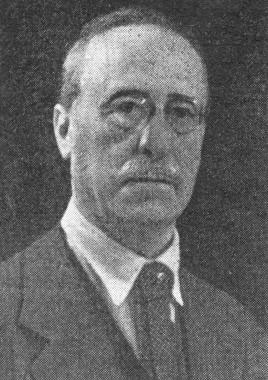
Jacques Mieses
Peter Anderberg (Harmstorf, Germany) pointed out in C.N. 4733 that the tale
was published on pages 169-170 of Schachwart, September 1932, as follows:
‘Ein Wortspiel.
Als Mieses vor langen Jahren in England weilte, stellte ihn der damals
recht bekannte englische Amateur Judd einem anderen englischen Spieler mit
den Worten vor: “Mister Meises – ”. Hier unterbrach ihn
Mieses lächelnd und wandte sich an den Engländer: “Entschuldigen Sie,
aber ich bin nicht Mister Meises, sondern Meister Mieses.”’
Mr Anderberg commented that this report pre-dates B.H. Wood’s magazine
CHESS, which was first published in 1935. For our part, we remarked that
the reference to a well-known English (sic) amateur named Judd is strange
and that Assiac set the story not in England but in New York when relating it
on page 186 of The Delights of Chess (London, 1960):
‘One day in New York he was asked by a German-American who mispronounced
his name the English way: “Sind Sie Mister Meises?” “No,
sir”, he answered like a shot, “Ich bin Meister Mieses.”
The old boy was full of such anecdotes and reminiscences when he was in a
good mood.’
Grandmaster draw
We often discuss etymological/terminological matters, and C.N. 3803 asked when
the phrase ‘grandmaster draw’ was coined. On the first page of the
Introduction to his book Prague 1946 (Sutton Coldfield, circa
1951) Harry Golombek wrote: ‘the number of so-called “grandmaster
draws” can be counted on the fingers of one hand.’ How much further
back can the phrase be traced?
Prodigies
C.N. 3818 sought information on a youngster referred to by Nikolai Grekov in
his reminiscences quoted (from where?) by J. du Mont on pages 14-16 of Capablanca’s
Hundred Best Games by H. Golombek (London, 1947):
‘The following curious episode took place during the 1936 Moscow tournament.
In the interval a 13-year-old schoolboy, Pavel Pomoschnikov, approached Capablanca
and in fluent French challenged the ex-champion to a game. Not wanting to
distress the boy, Capablanca consented. Having lost three games in succession,
Pavel Pomoschnikov demanded a handicap of a queen. Capablanca replied that
a queen was too much. The boy then solemnly declared that in ten years he
would play against Capablanca as an equal and with better success. The Cuban
champion advised the young champion to prepare well for the coming match and
presented him with an autographed copy of his book on chess.’
Can any reader take the story forward?
A Capablanca position?
The position below was discussed in C.N. 1670, having been culled from page
17 of the June 1988 issue of Europa-Rochade:
Capablanca was stated by the German magazine to have had White against an unidentified
opponent in an unidentified simultaneous display, and to have won as follows:
1 Qxd8+ Rxd8 2 f8(Q)+ Rxf8 3 Rxf8+ Nxf8 4 Nf7 mate.
Is anything more known about this game?
FIDE medals
We still lack information on a matter raised in C.N. 3882, i.e. what
became of the FIDE project reported on page 648 of the December 1980 BCM:
‘The International Chess Federation has decided to award gold medals
as follows: “Alekhine Medal” for the best attack; “Capablanca
Medal” for the best endgame; “Lasker Medal” for
the best defence, and “Steinitz Medal” for the best strategical
plan. A commission, composed of Dr M. Euwe (Chairman), GM G. Barzca, GM A.
Kotov, GM A. Matanović, GM M. Najdorf and GM L. Schmid, will select the
players that will be awarded the prizes annually at the FIDE Congresses. For
the first award, in 1981, games played in 1980 must be sent to the FIDE Secretariat
by 1 March 1981, with short commentaries ...’
Tom Thumb
C.N. 3931 asked whether reliable documentation was available about any involvement
with chess by General Tom Thumb – i.e. Charles Sherwood Stratton (1838-1883).
We mentioned that on page 216 of Brevity and Brilliancy in Chess by Miron
J. Hazeltine (New York, 1866) this game was given: 1 e4 e5 2 Nf3 Nc6 3 d4 exd4
4 Bc4 Nf6 5 Ng5 d5 6 exd5 Nxd5 7 Nxf7 Kxf7 8 Qf3+ Kg8 and ‘White announces
mate in three moves’. The heading was ‘A Mate by General Tom Thumb
(At least S. Loyd says it was.)’, and Loyd was named as the General’s
victim.
In C.N. 4323 Harrie Grondijs (Rijswijk, the Netherlands) added that the game appeared
on page 132 of
The Philadelphia Times Column of G. Reichhelm, 1879-1894,
published by Caissa Editions, Yorklyn
circa 1984:
‘General Tom Thumb according to the Editor of the News is an
excellent chess player for his size. The first game, the only one recorded
between the General and the Editor, was as follows: TT (White) – Editor
(Black) 1 e4 e5 2 Nf3 Nc6 3 d4 exd4 4 Bc4 Nf6 5 Ng5 d5 6 exd5 Nxd5 7 Nxf7
Kxf7 8 Qf3+ Kg8 and the General announced a mate in three.’
Our correspondent noted that the column was undated, which makes it particularly
difficult to identify ‘the Editor of the News’.
Flohr merchandising

Salo Flohr
C.N. 4177 quoted an affirmation, relating to the 1930s, in the Salo Flohr entry
on page 139 of The Encyclopaedia of Chess by Anne Sunnucks (London, 1970):
‘In Czechoslovakia he became a national hero, and Salo Flohr collars,
Flohr slippers, Flohr cigarettes and Flohr eau-de-Cologne appeared on the
market.’
It may be wondered what hard facts exist about such merchandising. In C.N.
4187 we drew attention to the following by George Koltanowski on page 440 of
CHESS, 14 August 1936:
‘Prague has Salo Flohr collars, Flohr slippers, Flohr cigarettes (he
is a non-smoker, too!), Flohr eau-de-Cologne, etc.’
Koltanowski wrote similarly about Flohr on pages 54-55 of his book “En
Passant” Chess Games and Studies (Edinburgh, 1937):
‘If you happen to stroll round Prague, a look at the various shop displays
will give striking evidence of his fame. Here can be seen Flohr collars, Flohr
slippers, Flohr Eau de Cologne, and (although he is a non-smoker himself),
Flohr cigarettes, and so on.’
Wanted: corroboration of this in a dependable source.
A famous miniature
This gamelet, examined in C.N. 4638, has been published many times:
1 d4 d5 2 c4 e6 3 Bf4 c5 4 Nc3 cxd4 5 Bxb8 dxc3 6 Be5 cxb2 7 White resigns.
He faces not only the loss of his rook but also 7...Bb4+.
But when and where was the game played, and by whom? Page 205 of The Quickest
Chess Victories of All Time by Graham Burgess (London, 1998) put ‘N.N.-R.
Bruening, Berlin, 1907’, which was the same as Irving Chernev had on pages
3-4 of 1000 Best Short Games of Chess (New York, 1955), except that Black’s
forename was given as Hans. Two decades later, on page 15 of Wonders and
Curiosities of Chess (New York, 1974), Chernev amended the occasion to ‘Milwaukee,
1908’, which was also what Kurt Richter had stated on page 21 of 666
Kurzpartien (Berlin-Frohnau, 1966).
Although 1908 is the most common date, it is impossible, because the game had
been published on page 108 of the January 1907 issue of Lasker’s Chess
Magazine:
Other text (e.g. on page 124) indicates that this January 1907 number was published
in February, which in turn suggests that the Bruening material appeared in the
Milwaukee newspaper in late 1906 or in January 1907. Can a reader find out more?
Submit information
or suggestions on chess mysteries
 Edward
Winter is the editor of Chess
Notes, which was founded in January 1982 as "a forum for aficionados
to discuss all matters relating to the Royal Pastime". Since then around
5,000 items have been published, and the series has resulted in four books by
Winter: Chess
Explorations (1996), Kings,
Commoners and Knaves (1999), A
Chess Omnibus (2003) and Chess
Facts and Fables (2006). He is also the author of a monograph
on Capablanca (1989).
Edward
Winter is the editor of Chess
Notes, which was founded in January 1982 as "a forum for aficionados
to discuss all matters relating to the Royal Pastime". Since then around
5,000 items have been published, and the series has resulted in four books by
Winter: Chess
Explorations (1996), Kings,
Commoners and Knaves (1999), A
Chess Omnibus (2003) and Chess
Facts and Fables (2006). He is also the author of a monograph
on Capablanca (1989).
Chess Notes is well known for its historical research, and anyone browsing
in its archives
will find a wealth of unknown games, accounts of historical mysteries, quotes
and quips, and other material of every kind imaginable. Correspondents from
around the world contribute items, and they include not only "ordinary
readers" but also some eminent historians – and, indeed, some eminent
masters. Chess Notes is located at the Chess
History Center.
Articles by Edward Winter
-
Edward Winter presents: Unsolved Chess Mysteries (1)
14.02.2007 – Since Chess
Notes began, over 25 years ago, hundreds of mysteries and puzzles have
been discussed, with many of them being settled satisfactorily, often thanks
to readers. Some matters, though, have remained stubbornly unsolvable –
at least so far – and a selection of these is presented here. Readers are
invited to join
in the hunt for clues.
-
Edward Winter presents: Unsolved Chess Mysteries (2)
12.03.2007 – We bring you a further selection
of intriguing chess mysteries from Chess
Notes, including the origins of the Marshall Gambit, a game ascribed
to both Steinitz and Pillsbury and the bizarre affair of an alleged blunder
by Capablanca in Chess Fundamentals. Once again our readers are invited
to join the hunt
for clues.
-
Edward Winter presents: Unsolved Chess Mysteries (3)
27.03.2007 – Recently-discovered photographs
from one of Alekhine’s last tournaments, in Spain in 1945, are proving baffling.
Do they show that a 15-move brilliancy commonly attributed to Alekhine is
spurious? And do they disprove claims that another of his opponents was
an 11-year-old boy? Chess
Notes investigates, and once again our readers are invited to join
in the hunt for clues.
-
Edward Winter presents: Unsolved Chess Mysteries (4)
10.04.2007 – What would have happened if the
score of the 1927 Capablanca v Alekhine match had reached 5-5? Would the
contest have been declared drawn? The affair has been examined in depth
in Chess Notes.
Here chess historian Edward Winter sifts and summarizes the key evidence.
There is also the strange case of a fake photograph of the two masters.
Join
the investigation.
-
Edward Winter presents: Unsolved Chess Mysteries (5)
30.04.2007 – We bring you a further selection
of mysteries from Edward Winter’s Chess
Notes, including an alleged game by Stalin, some unexplained words attributed
to Morphy, a chess magazine of which no copy can be found, a US champion
whose complete name is uncertain, and another champion who has vanished
without trace. Our readers are invited to join
in the hunt for clues.
-
Edward Winter presents: Unsolved Chess Mysteries (6)
19.05.2007 – A further miscellany of mysteries
from Chess Notes is presented
by the chess historian Edward Winter. They include an alleged tournament
game in which Black was mated at move three, the unclear circumstances of
a master’s suicide, a chess figure who was apparently unaware of his year
of birth, the book allegedly found beside Alekhine’s body in 1946, and the
chess notes of the poet Rupert Brooke. Join
in the hunt for clues.
-
Edward Winter presents: Unsolved Chess Mysteries (7)
02.06.2007 – The chess historian Edward Winter
presents another selection of mysteries from Chess Notes. They include an
alleged game by Albert Einstein, the origin of the Trompowsky Opening, the
termination of the 1984-85 world championship match, and the Marshall brilliancy
which supposedly prompted a shower of gold coins. Readers are invited to
join in the hunt
for clues.
-
Edward Winter presents: Unsolved Chess Mysteries (8)
In this further selection from Chess
Notes historian Edward Winter examines some unauthenticated quotes,
the Breyer Defence to the Ruy López, the origins of the Dragon Variation,
the contradictory evidence about a nineteenth century brilliancy, and the
alleged 1,000-board exhibition by an unknown player. Can our readers help
to solve these new
chess mysteries?
-
Edward Winter presents: Unsolved Chess Mysteries (9)
Why did Reuben Fine withdraw from the 1948 world championship?
Did Capablanca lose an 11-move game to Mary Bain? Was Staunton criticized
by Morphy for playing ‘some devilish bad games’? Did Alekhine
play Najdorf blindfold? Was Tartakower a parachutist? These and other mysteries
from Chess
Notes are discussed by Edward Winter. Readers are invited to join in
the hunt
for clues.
-
Edward Winter presents: Unsolved Chess Mysteries (10)
15.07.2007 – Did Tsar Nicholas II award the ‘grandmaster’
title to the five finalists of St Petersburg, 1914? What connection exists
between the Morphy family and Murphy beer? Can the full score of one of
Pillsbury’s most famous brilliancies be found? Did a 1940s game repeat
a position composed 1,000 years previously? Edward Winter, the Editor of
Chess
Notes, presents new
mysteries for us to solve.
-
Edward Winter presents: Unsolved Chess Mysteries (11)
01.08.2007 – Did Alekhine attempt suicide in 1922? Why is
1 b4 often called the Hunt Opening? What are the origins of the chess proverb
about the gnat and the elephant? Who was the unidentified figure wrongly
labelled Capablanca by a chess magazine? Does Gone with the Wind
include music composed by a chess theoretician? These and other mysteries
from Chess Notes
are discussed by the historian Edward Winter. Readers are invited to join
the hunt for clues.
-
Edward Winter presents: Unsolved Chess Mysteries (12)
12.08.2007 – This new selection from Chess
Notes focuses on José Raúl Capablanca (1888-1942). The chess historian
Edward Winter, who wrote a book about the Cuban genius in the 1980s (published
by McFarland), discusses a miscellany of unresolved matters about him, including
games, quotes, stories and photographs. Readers are invited to join
in the hunt for clues.
-
Edward Winter presents: Unsolved Chess Mysteries (13)
26.08.2007 – In a 1937 game did Alekhine play two moves in succession?
Can the full score of a Nimzowitsch brilliancy be found? Who was Colonel
Moreau? Why was it claimed that Morphy killed himself? Who were the first
masters to be filmed? What happened in the famous Ed. Lasker v Thomas game?
Is a portrait of the young Philidor genuine? From Chess
Notes comes a new selection of mysteries
to solve.
-
Edward Winter presents: Unsolved Chess Mysteries (14)
The latest selection from Chess
Notes consists of ten positions, including fragments from games ascribed
to Capablanca and Nimzowitsch. Was an alleged Bernstein victory a composition?
What is known about a position in which Black resigned despite having an
immediate win? Can more be discovered about the classic Fahrni pawn ending?
Readers are invited to join
in the hunt for clues.
-
Edward Winter presents: Unsolved Chess Mysteries (15)
Chess books repackaged as camouflage in Nazi Germany. Numerous contradictions
regarding a four-move game. The chess encyclopaedia that never was. Quotes
strangely attributed to Spielmann and Capablanca. These and other mysteries
are discussed in the latest selection from Chess
Notes. Readers are invited to join
in the hunt for clues.
-
Edward Winter presents: Unsolved Chess Mysteries (16)
Did Lasker invent a tank? Why did Mieses complain to FIDE about Bogoljubow?
What merchandising carried Flohr’s name? Who coined the term ‘grandmaster
draw’? What did Hans Frank write about Alekhine? Did Tom Thumb play
chess? These are just some of the questions discussed in the latest selection
from Chess Notes.
Readers are invited to join
in the hunt for clues.
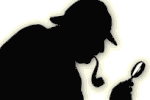


















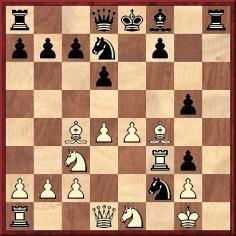

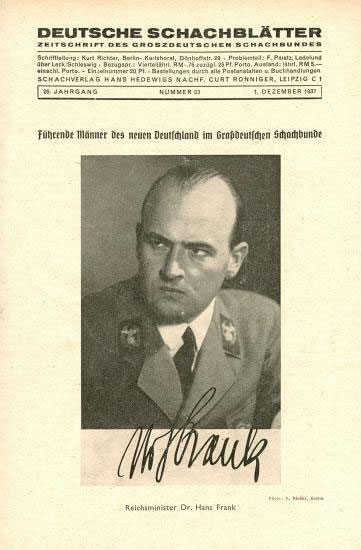

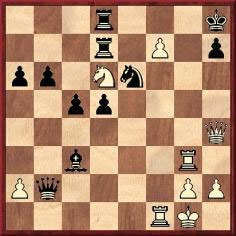


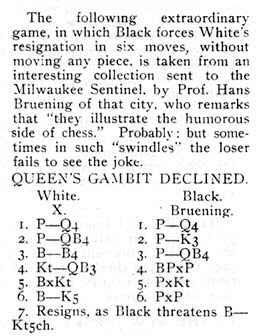
 Edward
Winter is the editor of
Edward
Winter is the editor of 




